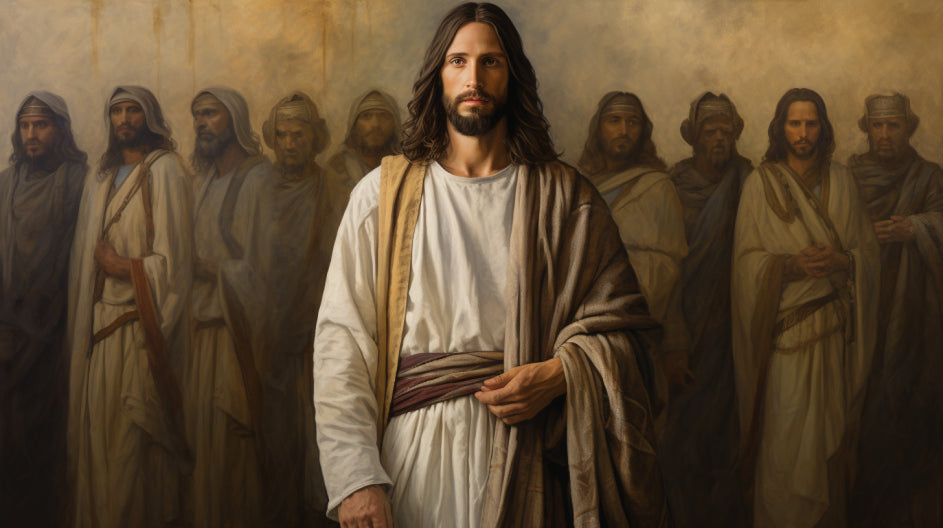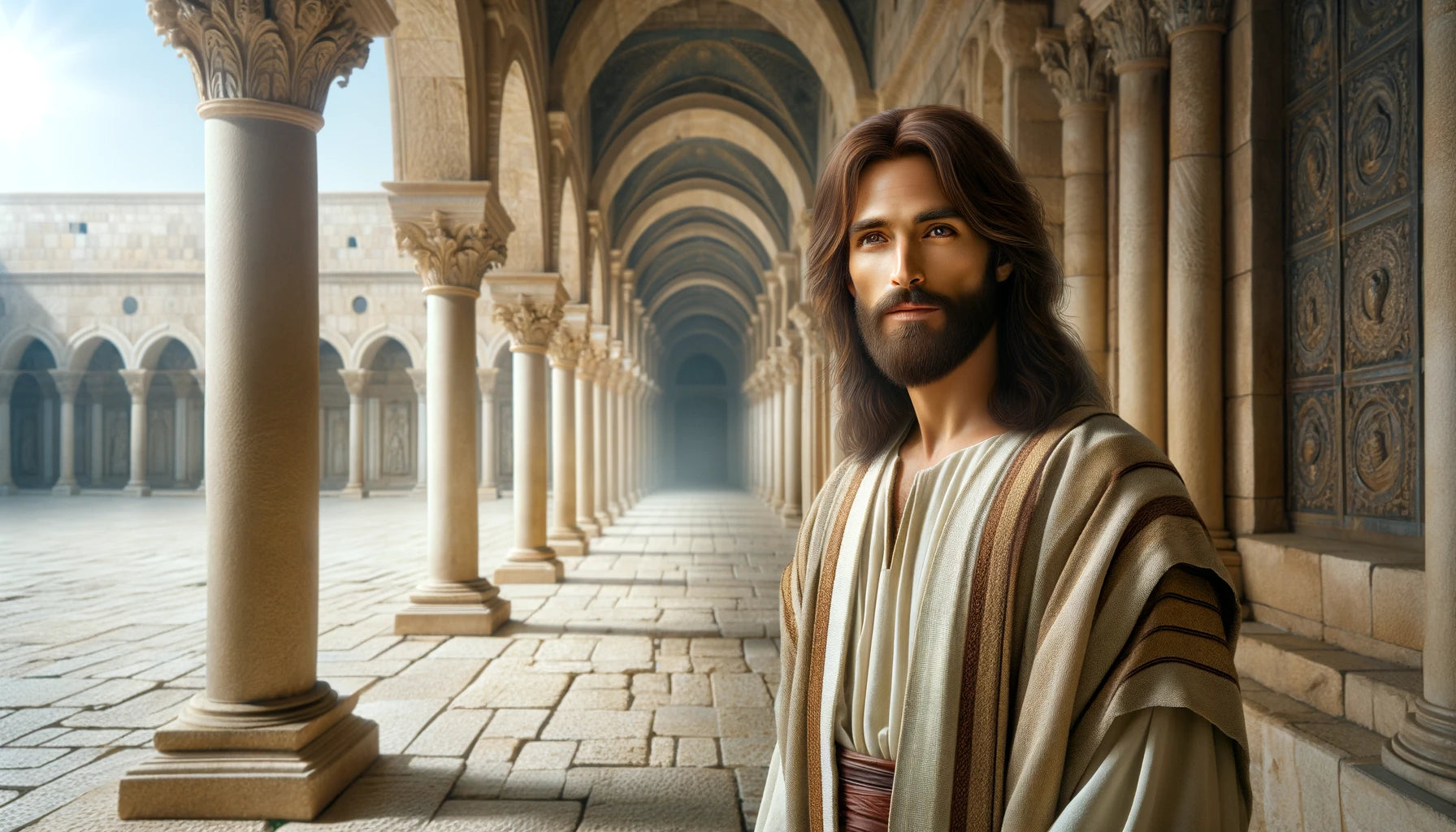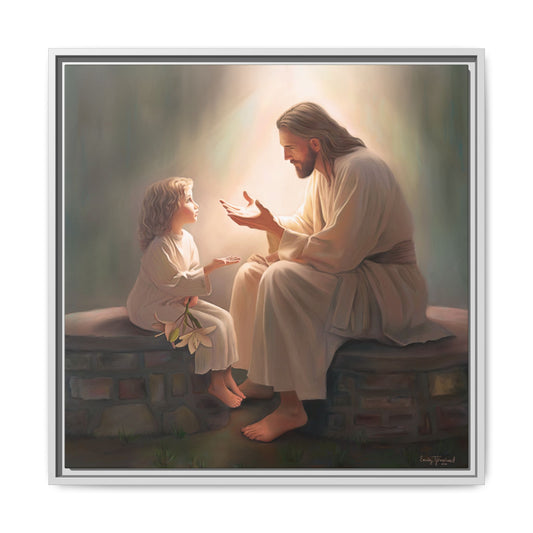
Does an Original Portrayal of Jesus Exist
Share
As we navigate the intricate tapestry of history, one cannot help but wonder: does an original portrayal of Jesus truly exist? The enigmatic figure of Jesus has been depicted in various forms throughout the ages, each bearing the imprint of the cultural and artistic milieu of its time. But amidst this panoply of representations, is there a singular, unadulterated image that captures the essence of Jesus? Join us as we unravel the complexities surrounding the portrayal of Jesus, from the early Christian rejection of aniconism to the controversies that have swirled around his depiction in art. Let's embark on a quest to uncover the truth behind the multifaceted nature of Jesus' portrayal, and see if we can unravel the mystery of his original likeness.











Key Takeaways
- The depiction of Jesus in early Christian art was initially varied before a standardized form emerged.
- Different cultures have depicted Jesus with their own ethnic characteristics.
- The appearance of Jesus in early Christian art varied, with some portraying him as a beardless young man and others emphasizing his ideal beauty.
- Modern variations and speculative depictions of Jesus have become more common, but traditional depictions still dominate in physical appearance and clothing.
Is there an original Jesus Portrayal
We believe it's important to consider whether there's an original portrayal of Jesus. The concept of Jesus portraits and their historical significance is an intriguing topic to explore. We aim to shed light on the significance of understanding Jesus as both a historical figure and a divine being, as well as the purpose of providing valuable information about the original Jesus and the significance of worshipful expressions of art.
The Significance of Jesus Portraits
The concept of Jesus portraits is rooted in the early Christian era. It was during this time that the portrayal of Jesus in pictorial form emerged and developed over several centuries. Eventually, this development led to a conventional standardized form of depicting Jesus. In the early depictions of Jesus, there was a great diversity. Some showed him as a beardless young man, while others portrayed him as a baby held by his mother. These early depictions also varied in terms of ethnic characteristics. As time went on, the appearance of Jesus in early Christian art continued to evolve. Different opinions emerged regarding how Jesus should be depicted. Some believed he should have the appearance of a young classical hero, while others argued for an unremarkable appearance. Controversies surrounded the depiction of Jesus, with different cultures portraying him with their own ethnic characteristics. This diversity of representations added to the richness and complexity of Jesus portraits throughout history. In modern times, variations in depictions of Jesus have become more common. However, traditional depictions still dominate, especially in terms of physical appearance and clothing. Nevertheless, there is a growing need for reform and recreation in depicting Jesus. As we grapple with the present moment, it is essential to reconsider how Jesus is portrayed and to ensure that his image resonates with the diverse and inclusive world we live in today.State the purpose of the article – to provide valuable information about the original Jesus and the importance of worshipful expressions of art
The evolution of Jesus portraits from diverse early depictions to modern variations underscores the need for reform and recreation in depicting Jesus as we strive to understand the significance of worshipful expressions of art. Our purpose in this article is to provide valuable information about the original Jesus and the importance of worshipful expressions of art. We aim to shed light on the historical and cultural significance of depicting Jesus in art and to explore the various interpretations of Jesus' appearance. By learning about the origins of Jesus' portrayal and the impact of different artistic expressions, we hope to offer insights that will enrich the understanding of the significance of art in worship. Our goal is to provide a comprehensive understanding of the original portrayal of Jesus and to highlight the profound significance of artistic expressions in the worship of Jesus Christ.
Introduce the importance of understanding Jesus as both a historical figure and a divine being
Understanding Jesus as both a historical figure and a divine being involves exploring the original portrayal of Jesus and the significance of worshipful expressions of art. This is crucial for comprehending the complexity and depth of his identity. Here's why this understanding is important:- Historical Context: Jesus' historical existence provides insight into his earthly life,
 teachings, and impact on humanity.
teachings, and impact on humanity. - Divine Nature: Recognizing Jesus as a divine being allows for a deeper understanding of his spiritual significance and the implications for faith and worship.
- Artistic Depictions: Art serves as a medium for expressing reverence and adoration for Jesus, reflecting diverse cultural interpretations and beliefs about his divine and historical nature.
- Spiritual Connection: Understanding Jesus in both realms fosters a deeper spiritual connection and enriches one's faith journey.
The Historical Context of Jesus
Let's talk about the life and times of Jesus Christ. We'll explore the historical context in which Jesus lived and the society in which he carried out his ministry. It's important to understand the cultural, political, and religious background of the time to gain a deeper insight into the original portrayal of Jesus.Discuss the life and times of Jesus Christ
The life and times of Jesus Christ are a central focus in understanding his impact on history and culture. From his birth and upbringing in Nazareth to his ministry in 1st-century AD, the historical and cultural context plays a pivotal role in comprehending his teachings and influence. It's essential to provide a brief overview of the biblical accounts of Jesus' early years in order to grasp the significance of his upbringing and the environment in which he carried out his ministry.Provide a brief overview of the biblical accounts of Jesus' birth, childhood, and early adulthood
Depicting the biblical accounts of Jesus' birth, childhood, and early adulthood provides a foundational understanding of the historical context of Jesus Christ.- Birth: Jesus was born in Bethlehem to the Virgin Mary.
- Childhood: He grew up in Nazareth, studying scripture and becoming wise.
- Early Adulthood: Jesus began his ministry around the age of 30, preaching, performing miracles, and gathering disciples.
- Impact: His teachings and actions transformed countless lives.

Talk about the significance of Jesus' upbringing in Nazareth
Jesus' upbringing in Nazareth holds significant historical and cultural importance in shaping his identity and ministry. Growing up in Nazareth, Jesus would have been influenced by the town's Jewish traditions and customs. This upbringing likely played a crucial role in shaping his understanding of service, humility, and compassion. Nazareth's community-oriented lifestyle may have contributed to Jesus' emphasis on serving others and fostering a sense of community in his ministry.Explain the historical and cultural context of Jesus' ministry during the 1st century AD
Growing up in Nazareth, Jesus would have been influenced by the town's Jewish traditions and customs, which set the stage for his ministry during the 1st century AD, a time marked by significant historical and cultural dynamics.- Roman occupation shaped daily life.
- Jewish religious leaders had significant influence.
- Apocalyptic fervor was prevalent.
- Varied Jewish sects, Pharisees, Sadducees, and Essenes, had distinct beliefs and practices.
The Biblical Description of Jesus
The biblical description of Jesus Christ is an essential aspect of understanding his character and impact. We'll explore the biblical portrayal of Jesus and the various characteristics and attributes attributed to him. This discussion aims to shed light on the historical and cultural context in which Jesus lived and how it shaped his depiction in the Bible.
Explore the biblical portrayal of Jesus Christ
As we begin to explore the biblical portrayal of Jesus Christ, it's important to highlight the key attributes and characteristics of Jesus as described in the Bible. We can discuss Jesus' teachings, miracles, and interactions with people, which offer profound insights into his divinity and humanity. Emphasizing the importance of understanding Jesus in both these aspects will provide a comprehensive understanding of his original portrayal in biblical accounts.Highlight the key attributes and characteristics of Jesus as described in the Bible
In the Bible, Jesus is portrayed as the compassionate and merciful savior who embodies love and forgiveness. His key attributes and characteristics include:- Compassion: Jesus showed deep empathy and kindness towards others, especially the marginalized.
- Mercy: He offered forgiveness and second chances, emphasizing the importance of grace.
- Love: Jesus preached unconditional love for all, regardless of social status or background.
- Humility: He exemplified modesty and servanthood, prioritizing the needs of others.

Discuss Jesus' teachings, miracles, and interactions with people
Exploring Jesus' teachings, miracles, and interactions with people reveals the profound impact he had on those around him. Jesus' teachings emphasized love, compassion, and service to others. His message was centered around the importance of treating others with kindness and showing love even to those who may be considered outcasts or sinners. He taught his followers to love their enemies and to forgive those who wrong them. Jesus' teachings challenged the societal norms and called for a radical change in how people relate to one another. His miracles demonstrated his divine power and compassion for those in need. Jesus performed numerous miracles throughout his ministry, such as healing the sick, raising the dead, and feeding thousands with just a few loaves of bread and fish. These miracles not only showcased his power, but also his deep concern for the well-being of others. He showed that he had the ability to alleviate suffering and bring hope to those who were desperate. Interacting with people, he showed humility, kindness, and understanding. Jesus was known for his approachability and willingness to engage with people from all walks of life. He showed compassion towards the marginalized, such as the poor, the sick, and the sinners. He listened to their stories, healed their afflictions, and offered words of comfort and guidance. Jesus' interactions with people reflected his deep empathy and desire to alleviate their pain and offer them hope. Jesus' life serves as a model for serving others and living with grace and love. His teachings, miracles, and interactions continue to inspire millions of people to follow in his footsteps and strive to make a positive difference in the world. Jesus' example teaches us the power of love and compassion in transforming lives and fostering a more just and compassionate society.Emphasize the importance of understanding Jesus' divinity and humanity
Understanding Jesus' divinity and humanity is crucial as we continue to explore the biblical portrayal of Jesus Christ after discussing his teachings, miracles, and interactions with people.- Jesus' divinity and humanity reveal his dual nature as fully God and fully human.
- Recognizing Jesus' divinity emphasizes his authority and power.
- Acknowledging his humanity allows us to relate to his experiences and empathize with his teachings.
- Understanding both aspects deepens our faith and appreciation for his sacrifice.
Jesus in Art Throughout History
Let's take a look at the depiction of Jesus in art throughout history. We can trace the evolution of how Jesus has been portrayed from the early Christian period to modern times.
Trace the depiction of Jesus in art from early Christian times
As we explore the depiction of Jesus in art throughout history, we'll discuss the different artistic styles and symbols used in representing Jesus. We will also examine famous artworks featuring Jesus and their impact on religious art. Additionally, we will analyze the influence of cultural and societal factors on the portrayal of Jesus. This journey will take us through the evolution of artistic interpretations of Jesus, shedding light on how different periods and regions influenced the visual representation of one of the most iconic figures in religious art.Discuss the different artistic styles and symbols used in representing Jesus
Throughout history, the depiction of Jesus in art has evolved through various artistic styles and symbols, reflecting the cultural and religious influences of different time periods.- Early Christian Art: Varied portrayals before standardized form.
- Ethnic Characteristics: Depictions reflect cultural influences.
- Controversies: Historical debates and iconoclastic movements.
- Modern Variations: Local traditions and speculative depictions.

Examine famous artworks featuring Jesus and their impact on religious art
Famous artworks featuring Jesus have significantly influenced religious art throughout history. They have shaped the depiction of Jesus in art from early Christian times and continue to do so today. These artworks have had a profound impact on religious iconography, influencing how Jesus is portrayed and perceived in various cultures. From the earliest surviving Christian art to modern variations, these depictions have played a crucial role in shaping the visual representation of Jesus in religious contexts.Analyze the influence of cultural and societal factors on the portrayal of Jesus
The impact of famous artworks featuring Jesus on religious art has been significant, shaping the depiction of Jesus throughout history, especially in relation to the influence of cultural and societal factors on his portrayal.- Art reflects cultural perceptions of Jesus.
- Societal norms influence the portrayal of Jesus.
- Ethnic characteristics are often depicted in art of Jesus.
- Controversies surrounding Jesus' portrayal reflect societal and cultural tensions.
The Significance of Worshipful Expressions of Art
As we move forward in our exploration of the portrayal of Jesus, it's important to consider the role art plays in expressing and deepening one's faith. Art has the power to evoke deep emotions and spiritual connections, allowing individuals to engage with their beliefs in a visual and tangible way.
Discuss the role of art in expressing and deepening one's faith
Art plays a significant role in expressing and deepening our faith. It has the power to inspire awe, reverence, and devotion, connecting us to the transcendent nature of God. Through worshipful art, we can explore the beauty and spirituality that shapes our spiritual experiences and religious practices, creating a profound connection to the divine.Explain how worshipful art can inspire awe, reverence, and devotion
In worshipful art, we find a powerful source of inspiration that ignites awe, reverence, and deep devotion. Jesus' portrayal in art evokes a sense of spiritual connection. Artistic representations create a tangible link to the divine. Visual depictions inspire contemplation and prayer. Art serves as a medium for expressing and strengthening faith in Jesus. Worshipful art not only captures the essence of devotion but also fosters a profound connection with the divine.Explore the connection between beauty, spirituality, and the transcendent nature of God
Beauty, spirituality, and the transcendent nature of God are intricately intertwined in the profound expressions of worshipful art. Art serves as a powerful vehicle for deepening our faith and expressing our devotion to Jesus. Through the use of color, form, and symbolism, art has the ability to evoke awe and reverence, allowing individuals to connect with the divine on a spiritual level. This connection to beauty and spirituality enriches our understanding of Jesus.
Provide examples of how Jesus Portraits have influenced spiritual experiences and shaped religious practices
The connection between beauty, spirituality, and the transcendent nature of God vividly comes to life through the profound impact of Jesus portraits on spiritual experiences and religious practices.- Jesus portraits serve as focal points for meditation and contemplation. They provide a visual representation that aids individuals in focusing their thoughts and connecting with their spirituality.
- They inspire awe, reverence, and a sense of divine presence. The artistic depiction of Jesus, often emphasizing his compassionate and loving nature, evokes deep emotions and a sense of awe in believers.
- They reinforce religious teachings and symbolize core beliefs. Jesus portraits often depict key moments from his life, such as the Last Supper or the Crucifixion, serving as visual reminders of the core teachings and beliefs of Christianity.
- They foster a sense of community and shared identity in religious worship. When displayed in places of worship, Jesus portraits create a shared focal point for believers, fostering a sense of unity and shared identity as they gather to worship and pray.
Controversies and Misinterpretations
Let's talk about the controversies and misinterpretations that have surrounded the portrayal of Jesus. There have been varying opinions and disputes about how Jesus should be depicted, with different cultures and traditions influencing the ethnic characteristics shown in his images. Additionally, historical events and theological views have also played a role in shaping the controversies around the depiction of Jesus.
Address common controversies surrounding Jesus Portraits
Let's acknowledge the ongoing debate over depicting Jesus' physical appearance, as it has sparked varied interpretations and controversies. It's crucial to explore the notion of 'authentic' or 'original' Jesus portraits and the potential for misinterpretation and idolatry in worshipful expressions of art.Discuss the debate over depicting Jesus' physical appearance
During the early period of Christianity, the portrayal of Jesus' physical appearance was a subject of intense debate and controversy.- Early Christians had varying opinions on the portrayal of Jesus in images.
- The issue of depicting Jesus remained controversial until the end of the 4th century.
- Images of Jesus tend to show ethnic characteristics similar to the culture in which the image was created.
- Different cultures have depicted Jesus with their own ethnic characteristics.

Explore the notion of "authentic" or "original" Jesus portraits
The debate over depicting Jesus' physical appearance has led to controversies surrounding the notion of 'authentic' or 'original' Jesus portraits. Many interpretations of Jesus' appearance exist, each claiming to be the most authentic representation. The search for an original portrayal of Jesus reflects our desire to connect with Him in a tangible way. However, it's essential to remember that the true essence of Jesus transcends physical appearances, emphasizing His spiritual teachings and universal love.Examine the dangers of misinterpretation and idolatry when it comes to worshipful expressions of art
Examinations of worshipful expressions of art reveal the potential dangers of misinterpretation and idolatry, particularly when it comes to controversial depictions of Jesus.- Misinterpretation can lead to false understandings of Jesus' identity and teachings.
- Idolatry in art may lead to the worship of the artwork rather than the spiritual truth it represents.
- Controversial depictions of Jesus can spark division and conflict within religious communities.
- Artistic interpretations of Jesus may inadvertently perpetuate cultural biases and stereotypes.

The Role of Jesus Portraits in Contemporary Worship
As we explore the role of Jesus portraits in contemporary worship, it's essential to consider how these depictions continue to shape modern worship practices. The relevance of Jesus portraits is evident in the way they provide a visual representation of the divine and serve as focal points for worship. Understanding how Jesus portraits resonate with worshippers today can offer insights into the enduring impact of visual representations in religious practices.Explore how Jesus Portraits continue to be relevant in modern worship practices
Let's talk about how Jesus Portraits play a crucial role in contemporary worship practices. From adorning the walls of churches and homes to being utilized in religious ceremonies, these portraits hold significant importance in both communal and personal worship. We'll also explore practical tips for integrating Jesus Portraits into our spiritual lives, allowing us to enhance our connection with the divine.Discuss the use of Jesus Portraits in churches, homes, and religious ceremonies
How do Jesus portraits continue to play a significant role in contemporary worship practices in churches, homes, and religious ceremonies?- Visual Representation: Jesus portraits provide a visual representation of Christ, aiding in meditation and prayer.
- Cultural Connection: They offer a cultural connection, depicting Jesus with local racial characteristics.
- Devotional Aid: Portraits serve as a devotional aid, reminding worshippers of Jesus' presence and teachings.
- Symbol of Faith: Displaying Jesus portraits in churches and homes symbolizes faith and devotion to Christ.
Highlight the significance of communal and personal worship through art
Exploring the role of Jesus portraits in contemporary worship reveals their enduring significance in both communal and personal religious practices. Art portraying God connects us to the divine, enriching communal worship and personal devotion. Through visual representations, we encounter God's presence, fostering a deeper spiritual connection. In communal worship, these portraits serve as focal points for collective reverence, while in personal worship, they provide a tangible expression of individual faith.
Provide practical tips for incorporating Jesus Portraits in one's spiritual life
Incorporating Jesus Portraits in our spiritual lives offers a tangible connection to the divine, enriching both communal worship and personal devotion. Here are practical tips for integrating Jesus Portraits into our spiritual journey:- Create a dedicated sacred space for displaying Jesus Portraits.
- Use Jesus Portraits as focal points for meditation and prayer.
- Incorporate Jesus Portraits in devotional practices and rituals.
- Reflect on the symbolism and message conveyed by Jesus Portraits.
Conclusion
We have examined the early Christian attitudes towards the portrayal of Jesus, the controversies surrounding depictions of Jesus, and the evolution of Jesus' appearance in early Christian art. It's crucial to understand Jesus as both a historical figure and a divine being, and to appreciate the various ways in which different cultures have depicted him. Embracing worshipful expressions of art can serve as a means to deepen our spiritual connection with Jesus and encourage a broader understanding of his significance in different contexts.Summarize the key points discussed in the article
The key points discussed in the article about the original portrayal of Jesus are:- Early Christian art and architecture depicted Jesus in varied forms before a standardized portrayal emerged around AD 300.
- Depictions of Jesus often reflected the ethnic characteristics of the culture in which the image was created, leading to diverse representations.
- Controversies surrounding the portrayal of Jesus persisted throughout history, with periods of iconoclasm and debates within different Christian traditions.
- Modern variations and speculative depictions of Jesus have emerged, reflecting local traditions and incorporating historical and anthropological research.

Reinforce the importance of understanding Jesus as both a historical figure and a divine being
Understanding Jesus as both a historical figure and a divine being is essential for comprehending the complexity of his impact on human history and spiritual beliefs. Jesus, as a historical figure, walked the earth, interacting with people and leaving a tangible mark on society. Recognizing his historical existence allows us to appreciate the human experiences he encountered and the lessons he imparted. Simultaneously, acknowledging Jesus as a divine being is crucial for understanding the spiritual significance and the transformative power of his teachings. It enables us to grasp the depth of his message and the profound effect it has had on individuals and societies throughout history. Embracing both aspects of Jesus provides a holistic understanding of his influence, guiding us in serving others with the same love, compassion, and grace he embodied.Encourage readers to embrace worshipful expressions of art as a way to deepen their spiritual connection with Jesus
Embracing worshipful expressions of art can profoundly deepen our spiritual connection with Jesus. As we seek to follow Jesus more closely, here are some ways in which embracing worshipful art can enrich our spiritual journey:- Reflective Meditation: Engaging with holy art can create a space for quiet reflection and meditation, allowing us to connect more deeply with Jesus in our hearts and minds.
- Heavenly Inspiration: Artistic expressions of Jesus can inspire us to contemplate the divine and the heavenly, drawing our thoughts and desires towards the holy and eternal.
- Community Engagement: Creating and experiencing art in a community setting can foster a sense of unity and shared devotion, strengthening our relationships with others who are also on the path of following Jesus.
- Creative Worship: Through art, we can creatively express our love and reverence for Jesus, offering a unique form of worship that deepens our connection with the divine.





